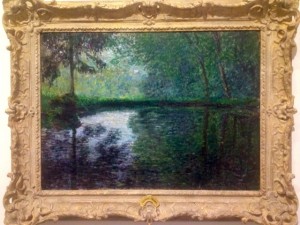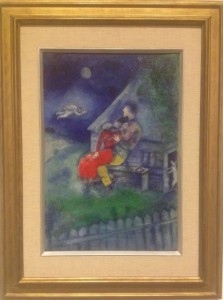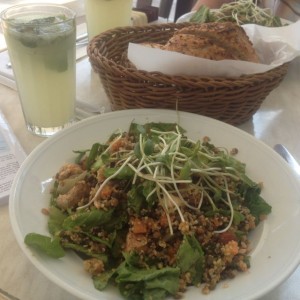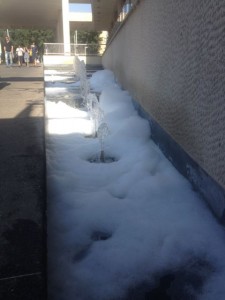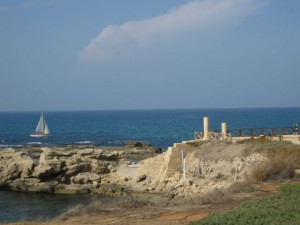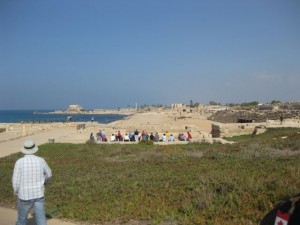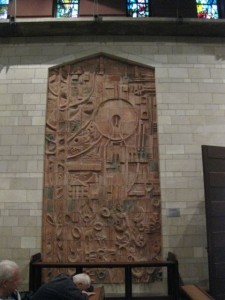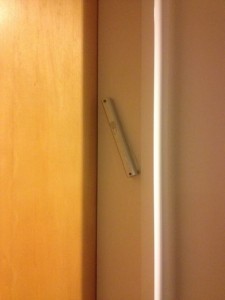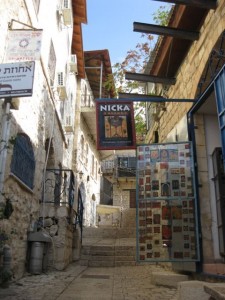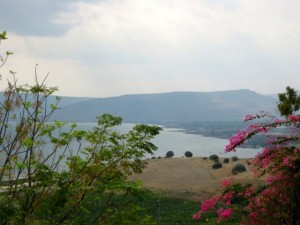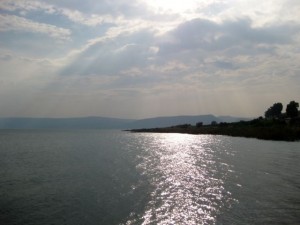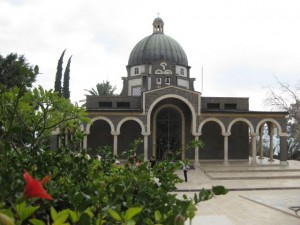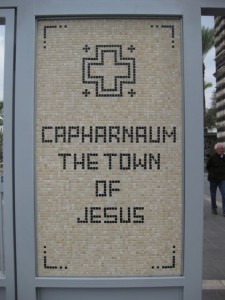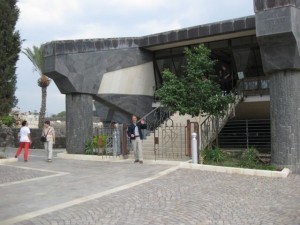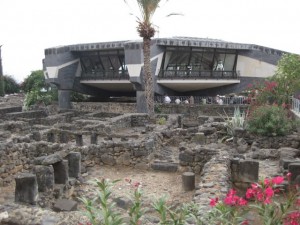Saturday was our last free day in Tel Aviv before we joined the tour on Sunday. Because Saturday is the sabbath, which is taken very seriously by observant jews, almost all businesses, activities, and public transportation were closed for the day. We enjoyed the day by visiting the Tel Aviv Museum of Art and wandering through some lovely older neighbourhoods. In all of this it was most enjoyable seeing the city residents out with their families and friends enjoying the lovely weather and an interesting lively city.
The museum of art has a dismal old masters section buried deep in the basement which only required a brief curtesy review. The impressionist and post impressionists were a different matter. The collection, to my appreciative but uninformed eye, seemed extensive (but not exhaustive) and interesting. Neither of us has seen that many Chagall pictures in one place before and I was reminded how much fun his stuff is!
Afterwards we enjoyed a lovely lunch in a square at a cafe squeezed in amongst the lively families. I’m loving the food here – it is so fresh with hummus, pita, veggies, fruit, veggies, fruit… all the yummy things I’ve been missing in the past few months.
Bright and early Sunday morning the van for our tour picked us up at our hotel. This tour is different from the others I have done in that everyone is staying at different hotels depending on the star rating you chose. We seem to be the only 3* folks. It is also different in that it is mostly what I like to think of as a “hop-on-hop-off” tour where you drive from site to site and jump out of the van for a fairly quick run through the site or just a photo opportunity. In this style we have covered quite a bit of ground so far.
On Sunday, yesterday, we first headed north from Tel Aviv along the coast. Our first stop were the ruins of the Roman settlement of Caesarea. It seems to be a pretty well preserved site with an amphitheater that is still used for concerts (apparently an Israeli artist is “made” by performing here), good parts of the old hippodrome, and the old harbour. It is in a lovely location right by the sea.
Our next stop was back to Haifa for another look at the Ba’hai Gardens. I’m glad that we came here on our own as the photo stop at the top of the gardens really didn’t convey the true beauty and scale of it to the other members of our tour.
We also visited what was called a Druze village for lunch and an chat by a Druze in a local home. I don’t seem to have taken any pictures as it wasn’t very remarkable in the end. It was just a normal village, a normal lovely lunch with Israeli style food, and a normal middle eastern home followed by the expected sales pitch to visit the local family store. The Druze are a religious and ethnic group originating in Egypt in the mid-900s. They are a closed community in that only Druze can live in this village and you can only marry a Druze if you want to stay within the community, otherwise you are banished.
Our final stop of the first day was Nazareth to visit the Church of the Annunciation on the location where the Angel Gabriel informed Mary she would be impregnated by the holy spirit. The site is owned and managed by the Franciscans but is open to all faiths (there is a separate site though for Orthodox christians who think it happened at a different spot). The church is built over the site of Mary’s house and was built in the 1960s.
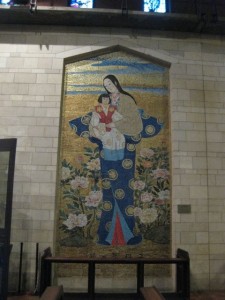
Many nations and communities have donated decorations – this is from Japan and Mary’s blouse is entirely covered in pearls
Last night and tonight we are staying at a kibbutz. The guesthouse is more like a conference centre than the rustic guesthouse I had imagined. However, as this is Israel, each hotel room door frame has a mezouzah (holding a mini version on the Torah) on it.
The second day of the tour has been equally as whirlwind as the first. After an early start this morning, we headed to the north eastern part of the country around the Sea of Galilee and the Golan Heights.
First stop was the small hill top town of Safed (Tsafat) which is the centre of Judaic mysticism and study of Kabbalah and since the 60s has been a mecca for artists. It was a lovely town to wander through for a nice stroll and some boutique browsing. I met a really nice young woman from Toronto who is living there for a year to explore what it means to be a modern Jew. She is working in a shop but as we were talking she walked with me down the main shopping street explaining the art and introduced me to the artists. It was a lot of fun!
Next we headed below sea level to the Sea of Galilee which is a lovely massive lake that supplies 25% of Israel’s fresh water and is still an active fishing location.
On the shores of the lake we visited the Mount of Beatitudes which is the traditional site of Jesus’ delivery of the sermon on the mount. It was a lovely setting. The entire estate is owned and managed by the Italian government since the 1930s.
Just around the bay is Capernaum which is believed to be the site of of Peter’s house. As this is a holy site, there is a church built over top of the archeological ruins of not only the Roman-era house, but also the earlier Byzantine churches. In this case though, I couldn’t help but think it looked like a flying saucer suspended above the ruins. At each of these sites, there are large groups who are on pilgrimage. They are often lead by a priest and may include nuns. Today, one of the groups was in the church so we got to enjoy some lovely but brief singing.
After lunch we drove further up into the Golan Heights which were occupied by Israel during the 1967 6-day war with Syria. Since then the area has been repopulated by Jews (all the Syrian Arabs fled) and various agricultural industries have developed. We learned all this by watching a cheesy multi-media presentation put on as propaganda by the local tourism council. However, we did get to go to a winery and sample local wines which was fun. Dad and I have actually already been sampling different Israeli wines each night and have enjoyed them very much. I will definitely be looking for them at the LCBO when I get home!
Our last stop was as far north east as we could go. We ended up within a few miles of the Syrian border. We could look out across the fertile valley to a stand of trees which marked the start of Syria. In the middle of our view was the large, white compound of the UN observation force which has been stationed here since the 70s to enforce the ceasefire (there has never been a peace treaty).

